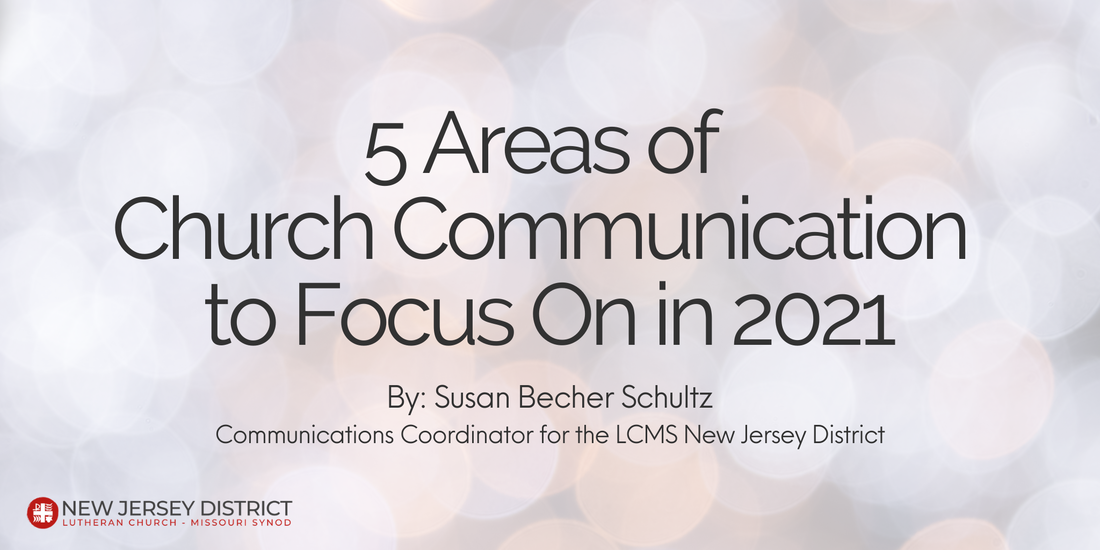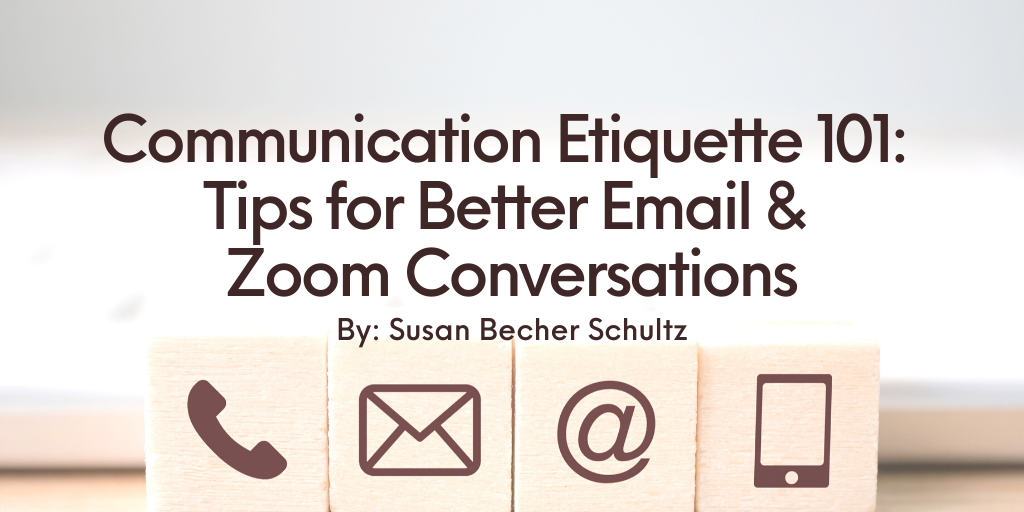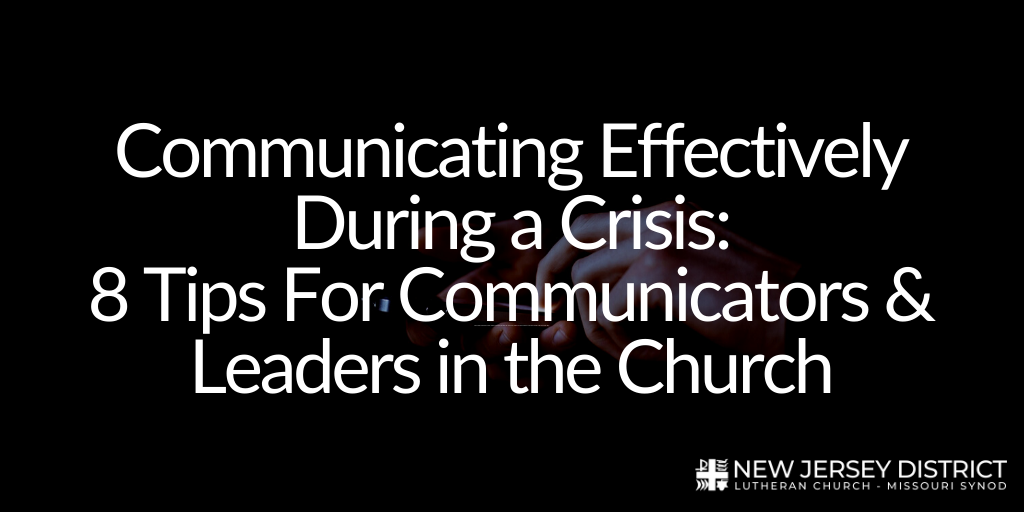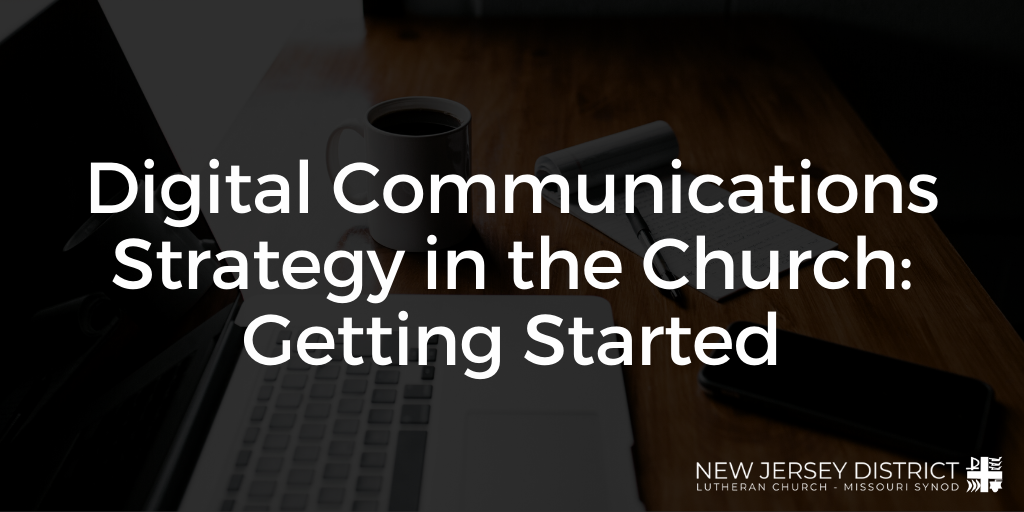|
Just as we set personal goals at the beginning of a new year, it’s important to do the same for our church communication strategies. As the digital world continues to grow in importance, it is easy to become overwhelmed and confused on where to start. This is where I suggest setting small but achievable goals! Below are five areas I believe are important to focus on in the upcoming year:
1. Use digital communication to engage but not replace personal communication: With the pandemic we’ve seen digital means of communication become essential, making it easy to lean heavily on it even as restrictions lift. While digital communication will remain an important component going forward, maintaining other forms of communication is just as essential. Members and newcomers alike want to feel like they are a part of a community, which means wanting to be cared for and wanting to care for others. Here are just a few ideas on how to connect deeper as a congregation using both digital and other forms of communication:
2. Clean up and/or update your website: If you haven’t updated your website design in the last five years, it’s time to make it happen. If you need help redesigning your website, reach out to me at [email protected]. I can help at little to no cost to your church! Tips for updating your website:
3. Have digital components for your newsletter and giving: If you are still avoiding a digital newsletter and/or online giving, make 2021 the year to lean into it. The great part is you can set up both of these at little to no cost! Both make it much easier for members to connect and give without jumping through additional hoops. The easier you make it for people to learn more about your community, the easier it will be for them to join in and participate.
4. Don’t try to do it all! Focus on what you are doing well, then add one small thing at a time: You may be feeling the pressure to have a presence on every single social media platform along with a perfectly conducted livestream or prerecorded service. But I’d actually suggest not trying to do all of this. Start by looking at what you are already doing. If you only have a website and a Facebook page, great! Start there! See what can be improved on those two spaces. Maybe you’ve been putting off something for quite a while now. Focus on becoming more effective on the platforms you are on before creating a presence on another one. If you are ready to add another social media platform, awesome! Pick one that you’d like to explore, and again, set small goals to work toward creating an effective presence. It’s far more important to have a presence of quality over quantity. You are only adding to the unnecessary noise of the internet if you aren’t taking the time to post content that your congregation or visitors care about. 5. Continue to be upfront about safety precautions as the pandemic continues: We are all tired of COVID ruling our lives, but that doesn’t mean we throw out safety measures all together or assume everyone knows the rules by now. Continue to communicate clearly with your congregations as restrictions lift or become more strict. While people may not be happy to have their traditions disrupted, the safety of our neighbors is of utmost importance. Use your channels of communication to update members on added or lifted safety precautions, cancelled services, etc. Make sure the information is on the homepage of your website and posted clearly on your social media for those who may be planning to visit. While resolutions can set us up for disappointment, setting small goals and working toward them throughout the year is far more effective. Start small this year while updating your communications strategy and know I’m here to help! Reach out to me at [email protected] with any questions you have about your communications goal setting.
0 Comments
While some of the tips below may seem obvious to some, I find time and time again as a Communication Coordinator for the district that my daily digital conversations lack basic etiquette. Formal handwritten letters and hard copies are becoming a thing of the past, but that doesn’t mean proper use of grammar and tone should go away with it! Here are a few tips on how to better communicate in a digital sense:
Tips for Email Etiquette:
Tips for Zoom Etiquette:
As we prepare to gather back in person anxiety continues to grow as many questions about reopening go unanswered. As pastors and lay ministry, it undoubtedly is a challenging time where high expectations are placed upon you to provide parishioners with concrete, anxiety-easing answers. Though not all questions can be answered satisfactorily, clear communication is one effective way to speak into this time of the unknown. Here are a few ways to communicate clearly in the coming months as restrictions begin to lift in our communities.
1. Develop a clear, easy-to-read, instructive document that outlines the following: - Phases the church intends on implementing as restrictions lift in accordance with local authority mandates. Here are a couple of examples to explore: - Example from St. John’s Bloomfield - Relaunching the Church by the Billy Graham Center - What is required during each phase: - Cleaning supplies that will be used to disinfect - Social distancing rules - Amount of people allowed to enter - What people can expect to change: - Changes in regard to greeting others, communion, etc. - Singing/Music - New ways of entering/leaving the building - New signs/instructions posted around the church (see point #4) - What is expected from parishioners: - Wearing a mask - Distance apart - Diligence in hand washing - Follow any signs posted (see point #4) 2. Post this document in an accessible place on your website. Save the document in PDF format and place it on an easy to find place on your website which can then be linked to and shared on your newsletter and social media. Print it out and send it to everyone in your congregation, especially to those who don’t respond to digital communication. It may be helpful to develop a Pandemic Response Committee of your own within the church to help look over this document before distributing, or bring existing lay ministry on board to help prepare the church for changes and reinforce the importance of these changes. 3. Prepare your response to pushback. Develop kind but firm responses with your Pandemic Response Committee if you’ve gathered one, or among lay ministry, to handle situations before they arise. People may push for phases to end sooner, to not wear masks, etc. Keep referring back to the document you’ve created, which again, should be in an easy-to-find place whether online or a hard copy version. Reiterate that the first priority is to keep people as safe as possible, which may look like being overly cautious to some. The pastor alone should not be responsible for handling all of the pushback, which is why it’s so important to have a response team or lay ministry informed and on board to help support the pastor and point back to the document you’ve distributed. 4. Print out posters and instructions for your church building to post on the outside doors and within the building to remind people of safety measures. Before meeting in person it may be a good idea to take pictures of the posters throughout your building and put them in your newsletter and/or social media to prepare members for the changes being made before they get to the building itself. It will take a bit of the shock out of seeing their church building for the first time looking a bit different than they remember. Here are some posters from the CDC available for public use: 5. When entering a new phase, or returning to a previous phase, communicate it with all of your parishioners beforehand through your digital newsletter, during announcements, and by making phone calls. Point back to the original document you’ve put together about which phase you are entering or returning to and explain what this will look like. Your response team and/or lay ministry can help the pastor with this communication by helping to make phone calls and standing firm with the pastor if pushback occurs. While there are many uncertainties as we move forward in this pandemic, communication remains a key component in moving forward together. Leaders in the church can not possibly answer every question due to the nature of the virus, but with clear communication are better able to address those questions that can be answered. If you have questions on how you can better communicate with your congregation please don't hesitate to reach out to me at [email protected]. Communicating Effectively During a Crisis: 8 Tips For Communicators & Leaders in the Church3/25/2020 By: Susan Becher Schultz, LCMS NJ District Communications Coordinator Special thanks to Pastor Casey Kegley & Pastor Nathan Schultz for letting me pick their brains for this blog. During times of crisis, especially one as imminent and widespread as the coronavirus, knowing how to communicate effectively with our communities can be difficult. As we grapple with loss of control over our schedules, careers, and finances, there’s a tendency to either over-communicate in order to gain back some sense of control, or to shut down and struggle to communicate at all. While both are understandable responses, there are many ways to communicate with our communities in ways that provide connection, togetherness, and support, without underlying attempts to fix the situation at hand.
This is unnavigated territory for all of us. As communicators and leaders we aren’t immune to the same feelings of those we communicate with. While it is our job to convey connection, community, and hope during this time of crisis, let us openly admit that we are human and by no means have the ability to fix this crisis. After we do all we can to communicate and connect with our communities, we too have a call to reflect, do less, and care for ourselves during this time. Please stay home as much as possible, stay healthy, and stay in touch - we’re all in this together. I hope you found this blog helpful, thank you for taking the time to read! Email me at [email protected] with any questions, suggestions, or thoughts on future blog topics.
by: Communications Coordinator Susan Becher Schultz DON'T: Add random christian quotes, bible verses, christian jokes/graphics to your social media just to fill out content and to look like an active church. DO: Create a strategy to include meaningful posts with a mix of the following: - A video, link to an audio recording, or a quote or bible verse that directly relates to the previous/upcoming sermon or bible study. Think of something that will help people remember the sermon throughout the week. - Promote upcoming events (use Canva.com or another design platform to create graphics) - Showcase photos of church members actively participating in an event, bible study, in a community outreach event, etc. Make sure you have their permission first! - A thoughtful tidbit directly from the pastor. Possibly a quick video to remind of main points from the sermon, questions to keep in mind, etc. Can be in blog, video, or graphic format. - Share from another page in the LCMS community such as lcms.org or njdistrict.org - A post to promote newsletter sign-up or a new page on the website - Reminders of upcoming service or events times - Be creative and think of other ways to show the personality of your church community! DON'T: Record and post random videos just because video is a popular communication tool right now. DO: Spend time creating a well-thought out video strategy to cover a specific topic or question that is being asked not only in your church community but in the outside community that may be looking for a new place to worship. Have a plan to record something other than just the pastor talking at the audience, make the video visually interesting, invite guest speakers, and ask questions of your audience. DON'T: Expect a huge number of people in the community to show up to your event just because you posted it to social media. DO: Research a need in your community that is not being met and create an event geared towards that need after speaking with members in the community. Then begin to share the event with other community social media pages, such as Facebook groups in your city, across your social media, on your website, in your newsletter, and have members share the event post with their network. Create both digital graphics to promote online as well as a paper flyer to hand out or post on bulletin boards, or even to mail out. DON'T: Sign up for all social media platforms which may include Youtube, Facebook, Twitter, Instagram, Snapchat, TikTok, Reddit, and Blogspot, etc., out of fear of falling behind in the social media world. DO: Research where your audience is active and build specific strategies based on that particular platform, stick to 1-3 platforms that you can post to consistently, and possibly add another platform as time goes on if you have the capacity. Always start with a Facebook business page, then possibly explore Instagram and Youtube to see if it works for your church community. DON'T: Put every single church detail, update, and announcement into your digital newsletter. DO: Decide what works best for your church in terms of how often to send a newsletter. Maybe it's weekly, bi-weekly, or monthly depending on the amount of events going on at your congregation, or the capacity to create and send newsletters. Whatever you decide, include the most important upcoming events and topics and keep it short and to the point. The cleaner and easier to read the better. Use buttons to direct people away from the newsletter and to your website if there is a lot of information involved. DON'T: Try to be trendy by using every filter, hashtag, and feature on social media. DO: Use the social media platform, whatever one or few it may be, to authentically connect with your audience. You can add in a filter here and there as you grow acquainted with the platform, but since churches are trying to reach a wide-range of ages keep the communication simple and easy to access without going overboard. Younger generations can see straight through your attempt to look cool! DON'T: Rely on your digital communications to reinvigorate the church and fix all your problems.
Providing an easy to use 'New Here' card on the back of the pews which the pastor can introduce at the beginning of worship is a great way to provide a no-pressure connection with your church. DON'T: Overcrowd your website's homepage with information about the church. DO: Simplify your website with only need-to-know information for visitors, especially on the home page; those who are long-time members or more familiar with who you are can go to the other navigation tabs (though they need to be well-organized and easy to navigate) to find what they need. Creating a 'Current Member' tab is a great way to direct members towards what they need. What we want is for those coming to the website for the first time to have the information they need on the very first page they see. DON'T: Be afraid to sign up and offer an online giving platform to your congregation. DO: Speak with your leadership on why online giving is important and why the additional fee to use a platform shouldn't deter you from offering it. According to Nonprofit Source, 60% of church members are willing to give to their church digitally. Oftentimes, new members and visitors will be younger and more able to give online than to write a check or give cash. DON'T: Give up on updating your website or social media because it all just seems too difficult to keep up. DO: Reach out to me at [email protected], I'm the New Jersey District Communications Coordinator and will set up a time to speak more about your digital communications. I'll have a conversation with you and help you map out a digital communications strategy at no charge! Plus you can stay updated by checking this Communications blog and send me an email when you have questions. I hope you’ve found the information in this blog helpful! Keep an eye out for more blogs from me that will dive deeper into free/affordable communication tools to use, comparing social media platforms, using analytics, website design, creating digital newsletters, and other relevant information on communications in the church. If you have a question, a suggestion for a blog topic, or would like to loop me in on a meeting with your communications team feel free to email me at [email protected].
By: Susan Becher Schultz, Communications Coordinator for the LCMS NJ District When approaching the ever-evolving world of digital, the task of putting a digital communications strategy in place at your church likely seems completely overwhelming. The questions I hear around putting a strategy in place go a little something like this:
Only in this case the problem persists and worsens. If we reject all forms of digital communication, we reject opportunities to connect with not only the outside community but on another level our own internal church communities. There becomes a ‘them’ that likes one way of communicating, and a ‘they’ that likes another. Good communication, digital and nondigital, is inclusive, authentic, and evolves to continue to meet the needs of people. The goal here is to create healthy communication in our churches that loops everyone in, not only those who love a hard copy and not only those who prefer to use online giving. Good communication is meaningful and designed for everyone. Start Where You Are The key to finding a healthy way to communicate that works for your church is about finding balance; this isn’t a race or competition to be the fanciest high-tech superstar church, but to find the best ways to communicate with the congregation, the community, and those you hope to bring through your door on Sunday morning. People can easily see through when you are trying too hard, but on the other hand, there is a level of expectation as we come into 2020 to have a functional website, a digital newsletter, and at least one social media platform utilized regularly. This is where I extend an invitation to start looking at what is already in place at your congregation. What is already in place that can be improved upon? Most likely there is a website, but maybe it hasn’t been updated in a number of years. Maybe there is a printed newsletter sent out monthly that does a great job communicating to some members, but likely there are many who prefer to view everything on their mobile device. Set aside time to write out the communication channels you currently have in place and keep these in mind as we move to the next step. Find the Right People Along the same line of starting with what you’ve got, it’s a good idea to start with who you have as well. All churches are different; maybe you have an employee or a few employees interested in expanding their job roles into digital communication. Maybe you have congregation members that would love to help out in this arena. Maybe there’s a high school student who is looking for an internship to add to their resume (call it something fancy like Digital Communications Manager). There may be one person interested in social media, and another in the website, or one person who would love to do it all. Think through who you view as a good fit for this role, but also consider if this person is skilled, willing to commit, and has the time to give to this role. Extend a friendly invitation to this person to join the communications team, but make sure you give the space for them to say no or take time to think it through. You will need someone entirely dedicated and interested for this to be successful. Keep in mind it’s best to keep this team small, whether it’s one person who has the skills to manage all channels of communication, or 2-4 people who agree to take on different channels, we want as few cooks in the kitchen as possible. Clear communication easily gets bogged down if too many people are in the room giving their thoughts and opinions. By having only the pastor and communication team/person involved, strategy is much easier to discuss, put in place, and improve upon going forward. If you haven’t caught on yet, it’s best if the pastor is not in charge of the entire communications strategy. By putting a team or point person together, it takes a huge workload off of the pastor, and allows the pastor to attend meetings and provide content, but otherwise focus on their many other responsibilities. Once a team is in place it’s time to move to the next step. Put a Simple Strategy in Place You’ve taken stock of your current communication platforms and gathered the right people, now what? This is a great time to contact your team or communications person and set your first meeting time. Even if you have one hired communications person, meeting with them on a regular basis is necessary to have a successful digital communications strategy. It’s a good idea to pick a time and day that is good for all involved parties on a recurring basis. If you have volunteers on your team, I suggest once a month in the long-term and possibly every two weeks for the first couple months as the ball gets rolling. If your communications person is a hired employee, ongoing weekly or bi-weekly meetings may work best to keep progress on track. This isn’t going to be a one-time meeting, but a continuous effort in order to improve and maintain communications on a regular basis. It’s imperative to continually improve which may mean phasing out what’s not working and trying something new that does. This first meeting is a great time to invite me as the district Communications Coordinator to join in. Not only is it my job to effectively communicate for the district, but also to provide tools and support to congregations as we navigate the modern world of communications. I am happy to take a look at your current communication channels and help guide the conversation during the first meeting. This first meeting will lay the foundation for your wider communication strategy, so it’s important to have a very focused first meeting. Below is a list of suggestions for the first meeting agenda:
If you’d like me to join in for a few meetings after the first to review new content and communication channels, I’m happy to help. I do expect within a few months your team will be up and running on their own. As you continue to meet with your communication team, slowly but surely a full communications strategy will form as your team or point person tracks engagement and learns what’s working, and not working, at your church. While it may take time to develop the team and make sure the right people are involved, it is entirely possible to have a manageable communications strategy where the pastor is involved on a very small level. While I am fully aware the phrase ‘digital communications strategy’ may come across as menacing, when it’s broken down into small steps and customized for your church it’s all completely manageable. The beautiful thing about digital communications is we now have the full capability to connect with our communities in a more direct, meaningful, and far-reaching way than ever before. Now is a better time than ever to get started. I hope you’ve found the information in this blog helpful! Keep an eye out for more blogs from me that will dive deeper into free/affordable communication tools to use, comparing social media platforms, using analytics, website design, creating digital newsletters, and other relevant information on communications in the church. If you have a question, a suggestion for a blog topic, or would like to loop me in on a meeting with your communications team feel free to email me at [email protected].
|










